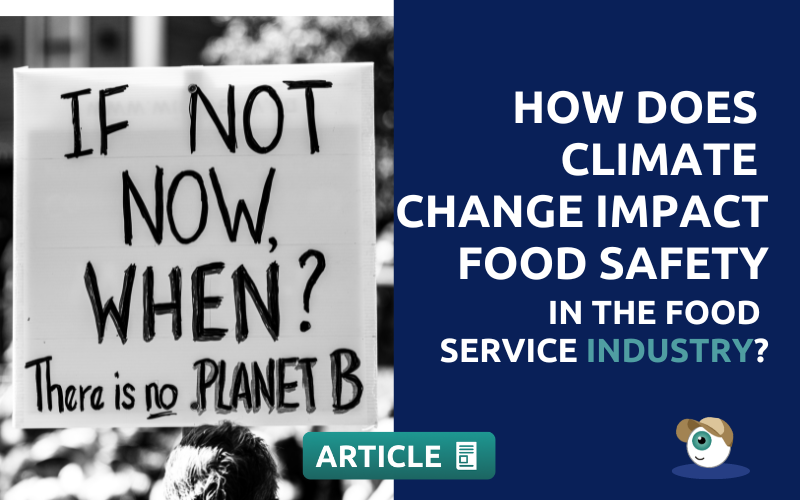How does climate change impact food safety in the food service industry?
While some may choose to deny it, climate change is a reality that is causing drastic transformations on the planet.
A 2023 report by the National Aeronautics and Space Administration (NASA), based on data obtained from satellites and ground observations, confirmed that 2022 was the sixth warmest year on record since 1880. And that the Greenland ice sheet has lost a record amount of mass in recent years, a loss that is contributing considerably to rising sea levels.
Another recent study in the journal Science concluded that climate change is intensifying droughts in some regions and floods in others, with serious consequences for agriculture, food security, and ecosystems.
And the list of ominous discoveries and terrifying warnings goes on.
Because, the effects of climate change extend to all sectors – including the food industry, where food safety is becoming an increasingly important concern.
This, and a lot more, in this post.
How does climate change impact food safety?
Increased temperatures and microbial growth
The rise in global average temperatures favors the proliferation of pathogenic bacteria in food.
A study published in the journal Applied and Environmental Microbiology (2018) found that a temperature increase of just 2°C can double the growth rate of Salmonella enterica, a bacterium that causes serious food poisoning.
This scenario also allows pathogens to survive in food for longer.
The World Health Organization (WHO) indicated in 2019 that climate change could increase foodborne diseases worldwide by 10% by 2050.
Impact on agricultural production and the supply chain
Droughts, floods, and extreme weather events associated with climate change directly affect agricultural production.
Water scarcity for irrigation limits crop yields, while floods can contaminate fields with sewage and pathogens.
A study published in the journal Nature Climate Change (2021) estimates that global yields of major food crops could fall by 7% to 30% by 2050 due to climate change.
This decline in production translates into a greater dependence on food imports, which increases the complexity of the supply chain and the associated risks to quality control and food safety.
Spread of toxins and foodborne diseases of plant origin
Rising temperatures and the disruption of the natural cycle of the seasons favor the appearance of fungi that produce mycotoxins in plant foods.
Mycotoxins are toxic substances produced by fungi that can contaminate cereals, nuts, fruits, and other agricultural products.
Exposure to mycotoxins can cause adverse effects on human health, such as gastrointestinal problems, immunosuppression, and even cancer.
A 2021 report by the European Food Safety Authority (EFSA) highlights that climate change could increase mycotoxin production in crops, posing a potential risk to food safety.
Proliferation of toxic algae and risks in seafood products
Ocean warming and acidification favor the proliferation of harmful algae (HABs).
These algae produce toxins that can accumulate in marine organisms intended for human consumption, such as mollusks, crustaceans, and fish.
Consumption of seafood contaminated with these toxins can cause various diseases, such as paralytic shellfish poisoning (PSP) and amnesic shellfish poisoning (ASP).
A study published in the journal Harmful Algae (2020) notes that the frequency and intensity of HAB blooms have increased in recent decades, which is directly related to climate change. This poses a challenge to the foodservice industry dedicated to seafood, demanding more rigorous control measures to guarantee food safety.
Impact on aquaculture and food safety of animal origin
Aquaculture, a fundamental source of animal protein, is also affected by climate change. Rising water temperatures, acidification, and decreased dissolved oxygen levels can cause stress and disease in farmed fish.
A 2022 report by the Food and Agriculture Organization of the United Nations (FAO) warns that climate change could reduce aquaculture production by 10% by 2050.
In addition, environmental stress can affect the quality and food safety of aquaculture products, as weakened fish are more susceptible to bacterial infections.
Strategies to mitigate the impact of climate change on food safety
In the face of this situation, what is clear is that: guaranteeing food safety is increasingly important, and apparently also more difficult.
But, as we will show below, it doesn’t have to be.
What measures can the food service industry implement to mitigate the risk that climate change poses to food safety?
Here are some suggestions:
Adopt sustainable agricultural practices: Reduce the use of chemical fertilizers and pesticides, implement efficient irrigation techniques, and promote precision agriculture to optimise resource use and minimise environmental impact.
Strengthen the supply chain: Implement rigorous quality control systems throughout the supply chain, from production to distribution and final consumption. This includes:
- Food traceability: Track the origin, movement, and destination of food products throughout the supply chain, from farm to fork. This allows for the identification of contaminated or at-risk products and enables quick and effective action to protect public health.
- Temperature monitoring: Monitor temperatures continuously during storage, transportation, and preparation to ensure food safety. Temperature deviations can create ideal conditions for bacterial growth and compromise food safety.
- Good hygiene and food handling practices: Implement and enforce comprehensive hygiene and food handling protocols to minimise the risk of contamination at all stages of the food service process. This includes proper handwashing, sanitising surfaces, and following safe food preparation techniques.
Invest in food safety technology: Implement technological solutions like 🧢 Andy App and temperature sensors to identify, prevent, and control food safety risks associated with climate change.
- Andy App: Software like Andy App helps food service businesses improve food traceability by tracking the origin, movement, and destination of food products throughout the supply chain. This allows for the identification of potential problems and facilitates the implementation of corrective actions.Additionally, Andy App offers features such as:
- Automated expiration date management: Eliminate manual entry errors and ensure accurate expiration information by capturing dates upon receiving products.
- Digital audit trails: Conduct thorough internal audits with customisable checklists to identify areas for improvement and maintain a digital record of findings for future reference.
- Data analysis for preventative measures: Leverage data collected through the app to identify trends and patterns that may indicate potential food safety risks, enabling proactive measures to prevent incidents.
- Temperature sensors and environmental monitoring: These devices provide real-time monitoring of temperature and environmental conditions in storage areas, vehicles, and other critical points within the supply chain. By identifying and addressing temperature deviations promptly, you can minimize the risk of foodborne illness.
Train your staff: Provide ongoing training to staff on the latest food safety practices and the specific risks associated with climate change.
- Training topics can include:
- Personal hygiene and sanitation
- Safe food handling techniques
- Foodborne illness prevention
- Emergency response procedures
- Climate change and its impact on food safety
Collaborate with stakeholders: Work together with governments, non-governmental organizations (NGOs), academia, and other stakeholders to develop and implement strategies to adapt to climate change and ensure food safety in the food service sector.
This collaboration can lead to:
- Joint research and development of innovative solutions to address food safety challenges arising from climate change.
- The creation of educational resources to raise awareness about climate change and its impact on food safety.
- The development of effective policy frameworks that support sustainable food production practices and robust food safety regulations.
The Role of Technology in Preventing Food Safety Issues
As we have seen, climate change will undoubtedly pose a significant challenge to food safety in the food service industry from now on. Rising temperatures, extreme weather events, and disruptions to the food supply chain all contribute to an increased risk of foodborne illness.
However, by implementing proactive mitigation strategies and adopting innovative technologies, we can work together to strengthen the resilience of the food service sector and ensure the safety of the food we consume.
Andy is there to help you all the way.
Major food service corporations, mid-sized franchises, and restaurant groups are already using Andy to achieve significant reductions in waste, optimise their operations, and improve overall productivity. These seemingly routine improvements translate to a substantial positive impact on the environment.
By minimising food waste through efficient food labelling and traceability protocols, businesses not only save money but also reduce their environmental footprint. Less wasted food equates to less food production, which in turn translates to a decrease in greenhouse gas emissions, water usage, and land degradation – all factors that contribute to the climate change impact on food safety.
Furthermore, optimising operational efficiency through features like real-time temperature monitoring and data analysis – key functionalities of Andy – helps businesses reduce energy consumption. This not only lowers operating costs but also lessens the environmental burden associated with fossil fuel reliance.
In other words, while Andy directly addresses the challenges of climate change by mitigating its impact on food safety, it also empowers businesses to become more sustainable through improved resource management and operational efficiency.
Collaboration among all stakeholders, coupled with the adoption of innovative solutions like Andy, is essential to protect public health, ensure food safety, and create a more sustainable future for the food service industry in a changing climate.
👉🏽START YOUR ANDY FREE TRIAL NOW👈🏽


